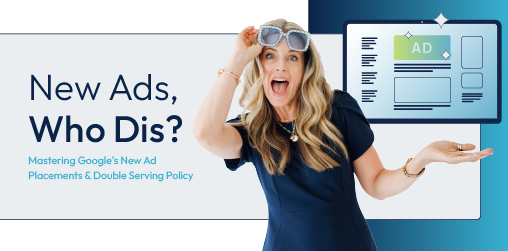The Algorithm Isn't Broken, Your Strategy Is
Maximizing Growth with a Cross-Channel Marketing Strategy
People have never made decisions in straight lines. We like to think we’re rational, but in reality, we flit from one idea to the next, chasing novelty, doubting ourselves, circling back. A product might catch our eye one day, but by the next, the spark has faded. Then something–an ad, a conversation, a reminder–pulls us back in. Human behavior has always been unpredictable, and marketing has always had to live with that reality.
The difference today is the sheer number of places those moments unfold. Social feeds, search engines, emails, text messages, video platforms–each one offers the chance to move someone forward or lose them entirely. Even the most polished campaign can falter when the next interaction feels disjointed or never comes at all. And with attention stretched across so many spaces, no single channel can guide the journey on its own.
Cross-channel strategy meets this reality head-on. It connects the scattered encounters, pulling them into a sequence that feels familiar instead of fragmented. When every touchpoint reinforces the last, the brand itself takes on a steadiness customers recognize and trust, no matter where their attention lands.
What Is Cross-Channel Marketing?

Cross-channel marketing is about connection. It connects businesses with customers across multiple platforms, creating more opportunities for engagement. Customers don’t move through channels in isolation. Instead, they carry impressions and expectations with them. This gives businesses the flexibility to tailor messaging based on where and how people interact, and to guide that journey as one connected experience.
For example, when someone shifts from an ad to an email, or from social to a website, the thread of the experience remains intact. The message is coherent, the tone consistent, the next step clear. Instead of managing campaigns in silos, a cross-channel strategy ties the spaces between them, creating a journey that feels seamless for the customer and efficient for the brand.
Cross-Channel vs. Multi-Channel vs. Omnichannel
The terms often get used interchangeably, but the difference comes down to how channels work together.
Multi-Channel Marketing
Multi-channel marketing means having a presence in more than one place, like your business’ social media accounts, email marketing efforts, paid ads, or website. Each channel operates independently, with its own campaigns and metrics. Customers may see the brand in several places, but the experiences aren’t intentionally connected. For example, your company might run a Facebook ad and send an email campaign at the same time, but those efforts don’t share data or build on each other.
Cross-Channel Marketing
Cross-channel marketing connects the dots a step further. Here, channels interact so the customer’s journey feels continuous and intentionally designed. A social ad may lead someone to the website, and the user later receives an email targeting that same campaign from the social asset. Because the channels are linked, the message feels more relevant, and the brand can retarget more effectively. This way, the customer experiences one ongoing, meaningful relationship with your brand.
Omnichannel Marketing
Omnichannel goes further by removing the barriers between channels altogether. Every touchpoint is part of the same conversation, whether online or offline. For instance, a shopper might browse a product on a mobile app, receive an abandoned cart email, see a personalized ad on Instagram, and then visit a physical store, where an associate already has access to their past interactions. The experience feels seamless, personal, and effortless at every step. As a whole, however, this approach requires advanced (and expensive) systems to be successful.
It's helpful to think of cross-channel marketing as sitting between the two extremes. It’s more connected than multi-channel but less complex than omnichannel, which makes it a practical and powerful approach for most businesses today.
Which Marketing Strategy Should You Choose?
For most businesses, cross-channel is the sweet spot. Multi-channel often leaves efforts scattered, with no clear thread tying them together. Omnichannel, while powerful, can be resource-intensive and difficult to execute without advanced systems and teams in place.
Cross-channel balances both worlds. It builds continuity across the platforms that matter most, without requiring a full-scale reinvention of operations. By linking campaigns so they work together instead of in isolation, cross-channel marketing creates a journey that feels connected for customers and manageable for brands. It’s a strategy that’s effective, sustainable, and can scale alongside your business.
ROI and Efficiency
At RivalMind, we’ve seen how brands that connect their efforts this way waste less, retain more, and grow faster. And for leaders, the real value lies in knowing they don’t have to choose between good strategy and good business.
When campaigns live in silos, budgets stretch thin. Ads repeat what customers have already seen. Emails reach the wrong people at the wrong time. Opportunities slip away in the gaps between platforms. Linking channels reduces that waste. Each touchpoint carries the last one forward, building momentum instead of starting over.
That efficiency translates into financial return. Customers who recognize consistency across platforms feel understood, and people who feel understood tend to stay longer, spend more, and advocate on behalf of the brands they trust. Over time, the value of those relationships far outweighs the initial cost of acquiring them.
Cross-channel also strengthens decision-making. Connected data offers a fuller picture of customer behavior, giving leaders clearer patterns to guide investment and refine campaigns. Instead of piecing together fragments, they see the whole.
But perhaps the most important outcome isn’t financial, it’s relational. Customers don’t just want a discount code in their inbox. They want to see the same clarity in the ad they scroll past,
the content they click, and the landing page they arrive on. When messaging aligns across every encounter, it signals reliability. Over time, reliability compounds into trust. And trust is what sets lasting businesses apart.
A Practical Path Forward
Cross-channel transformation doesn’t happen all at once. It unfolds in stages, and each step reveals new opportunities to connect with customers more effectively.
Audit
The first step is visibility. Many organizations don’t realize how often their messaging shifts tone, loses consistency, or creates friction between channels. An outside perspective can help uncover these gaps, turning what feels like scattered effort into a clearer picture of where connection is missing.
Connect
Once those gaps are visible, the next move is to begin linking channels. That might mean aligning website content with email campaigns, or ensuring paid ads lead to landing pages that feel like part of the same conversation. Even early connections create a more cohesive journey. But getting the data, timing, and creative aligned is rarely simple. It takes coordination across teams and platforms.
Scale
As systems mature, so does the opportunity to scale. This stage is where momentum builds as social, paid search, retargeting, and content come together in a network that feels seamless to customers and measurable to executives. However, while multi-channel strategies are built to add more platforms, without that connection piece, the result is often noise instead of clarity.
Managing Google Ads can be difficult and expensive.
Hire the experts in Google Ads management.
Key Marketing Channels
Every business has its unique mix, but most cross-channel strategies start with a familiar set:
Website
Let's talk web design →The hub where every other channel points.
Email
Emails that convert →Still one of the most effective tools for nurturing and retention.
Social Media
Let's get social →Builds awareness and engagement in real time.
Paid Search and Ads
Get clicks that count →Drives targeted traffic with measurable intent.
Content Marketing
Content that speaks →Creates the trust and authority that make other channels work harder.
Building Marketing That Lasts
Cross-channel marketing reframes the role of marketing itself. It turns a set of campaigns into a system that strengthens decision-making, sharpens collaboration, and creates experiences customers can trust. For executives, the impact is in leading with confidence, knowing every channel is working together toward the same outcome.
At its best, marketing feels less like a broadcast and more like choreography. Each step builds on the last until the whole performance feels seamless. That is the promise of cross-channel. Your marketing stops being a collection of efforts and becomes an ecosystem that adapts and grows with the people it serves.
However, the strongest marketing systems aren’t built for businesses, but rather they’re built with them. They take shape through the vision, goals, and dedication of a team, supported by a partner who helps every channel work efficiently.
And if you want marketing that compounds into trust, growth, and staying power,
RivalMind is ready to help you build it. Together, we can turn momentum into longevity and campaigns into a system that lasts.

Meet the Author
Jessica Goodrum
Marketing Director
Jessica Goodrum is the Marketing Director at RivalMind, responsible for brand management, marketing, social media, and networking. With over a decade of experience in digital project management, Jessica has a proven track record in driving business growth through innovative marketing strategies. She oversees the direction and success of RivalMind's marketing efforts and collaborative relationships, always striving to create authentic connections and deliver exceptional results. Jessica’s management philosophy is rooted in transparency, and clearly communicating project goals and the necessary steps to achieve them is a top priority.
Specialties: Brand Management, Media Relations, Keeping It All On Task
Looking for more organic website traffic?
Welcome to RivalMind. Our purpose is to help your business thrive. We are a digital marketing agency that offers SEO, PPC, Web Design, Social Media and Video Solutions as tools to our clients for online business development and growth.
Contact us today to get started!
Blog Contact Form
Connect with Us:






